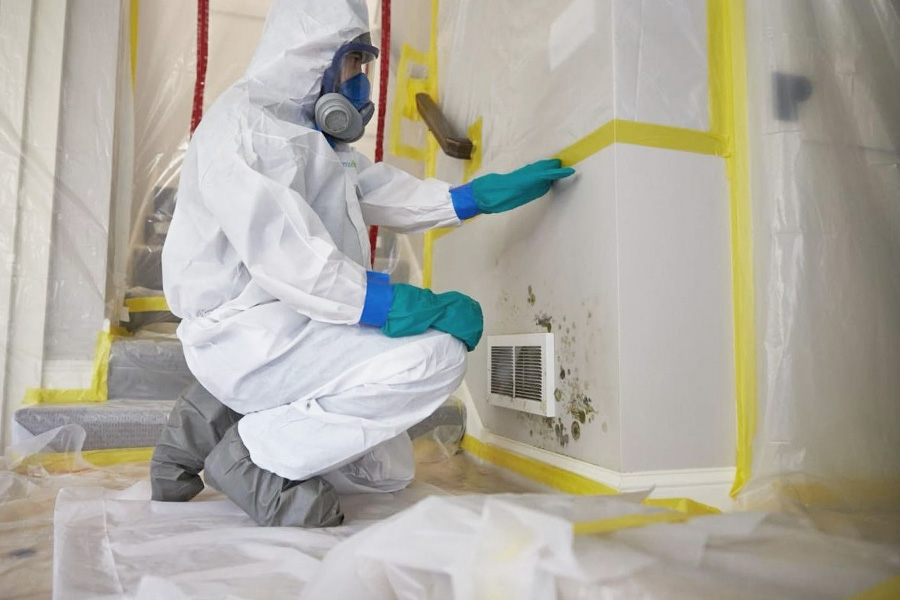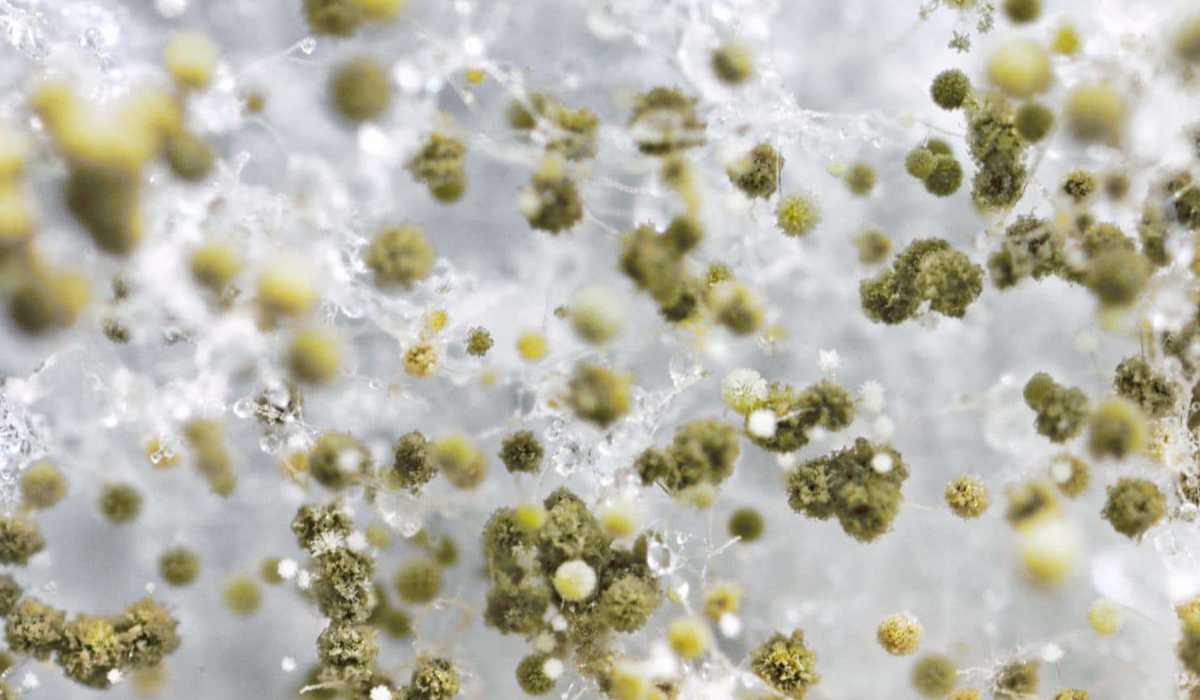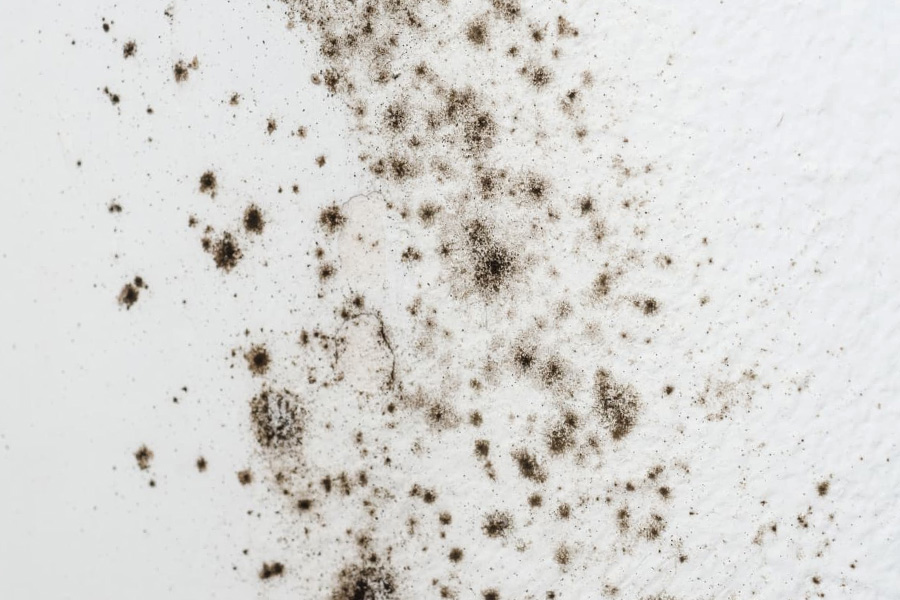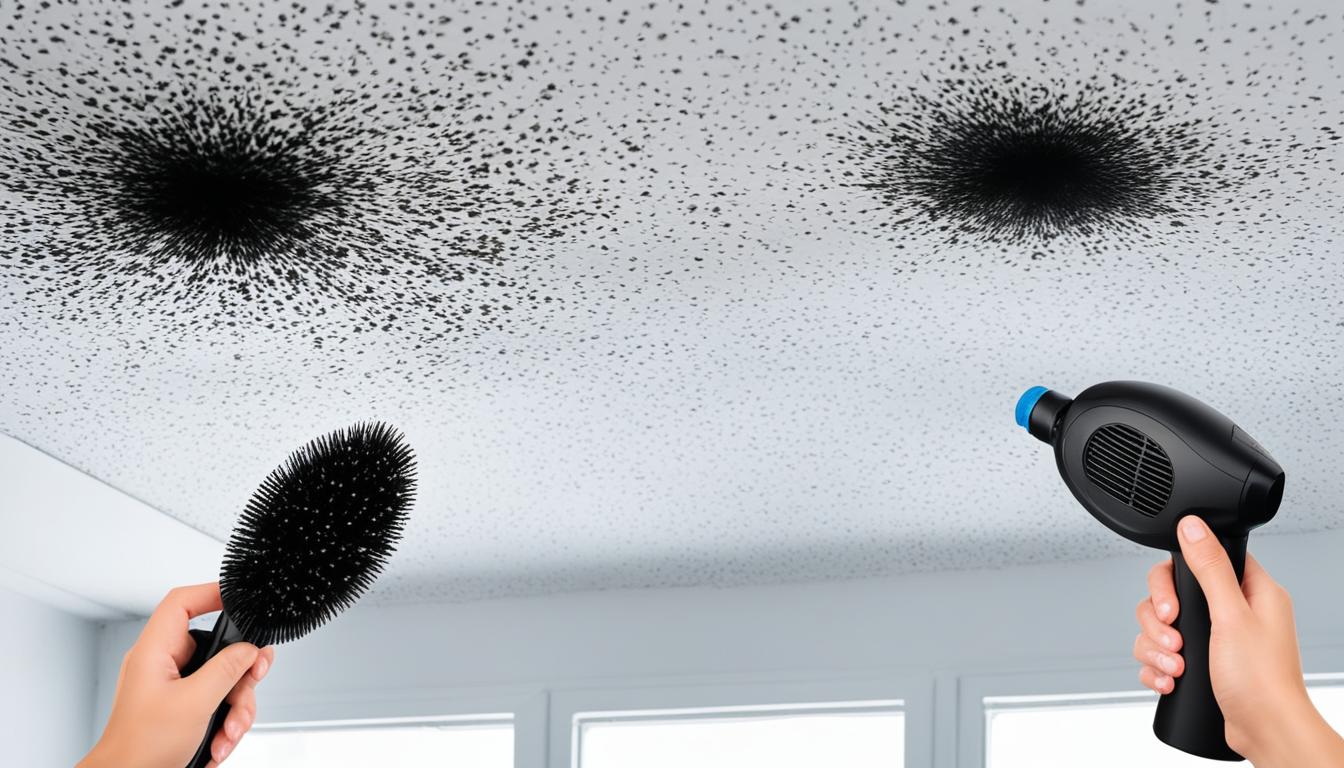
Combat Black Mold on Ceiling – Prevention & Removal
Black mold on the ceiling is a common household problem that can pose significant health risks to you and your family. It can grow in damp and humid areas, such as bathrooms, kitchens, and basements, and quickly spread if not addressed promptly. Preventing black mold on the ceiling and removing it effectively is crucial to maintain a healthy indoor environment.
In this article, we will explore the causes of black mold growth on ceilings, potential health risks, practical prevention tips, and effective removal methods. Whether you prefer the DIY approach or seek professional services, this guide will provide you with the necessary information to combat black mold on the ceiling.
Key Takeaways:
- Black mold on the ceiling is a common household problem that can pose significant health risks.
- Prevention and effective removal methods are crucial to maintain a healthy indoor environment.
- Proper ventilation and moisture control can help prevent the growth of black mold on ceilings.
- Diy methods for removing black mold from ceilings include using cleaning solutions and protective equipment.
- Professional mold inspection and remediation services, such as Fix Mold Miami, can provide reliable solutions for black mold on the ceiling.
Understanding Black Mold on Ceiling
Black mold on ceiling is a common problem caused by moisture accumulation, poor ventilation, and leaks. When these conditions persist, mold can grow and spread quickly, posing a health risk to the occupants of the affected building.
To understand the causes of black mold on ceiling, it is important to recognize the signs that indicate its presence. These signs include:
- Visible black or dark green spots or patches on the ceiling
- An earthy or musty smell in the room
- Excessive moisture or dampness in the air
- Water stains or discoloration on the ceiling
These signs may indicate the presence of black mold on the ceiling. It is important to take immediate action to prevent further growth and remove the mold as soon as possible to avoid adverse health effects.
Causes of Black Mold on Ceiling
The growth of black mold on ceiling is typically linked to moisture accumulation, which can result from:
- Water leaks from pipes, roofs, or windows
- Flooding or standing water
- Poor ventilation in humid areas
- Condensation caused by temperature changes or humidity
It is important to address any of these causes promptly, as ongoing moisture exposure provides optimal conditions for mold growth.
Summary
Black mold on ceiling is a common problem, typically caused by moisture accumulation and poor ventilation. Recognizing the signs and causes of black mold growth is crucial to prevent further damage and potential health risks.
Health Risks of Black Mold on Ceiling
Black mold on the ceiling poses serious health risks to individuals exposed to it. When disturbed, black mold spores can cause allergic reactions, respiratory issues, and even neurological problems. Prolonged exposure to this toxic mold can lead to severe health problems, which is why prompt action is necessary.
The symptoms of black mold exposure can include coughing, wheezing, headache, fatigue, and recurrent sinus infections. Individuals with pre-existing respiratory conditions, weakened immune systems, and allergies are particularly susceptible to the health risks posed by black mold on the ceiling.
That being said, in addition to causing health complications, black mold on the ceiling can also trigger significant property damage. When this mold invades different parts of the home, ranging from the walls to the ceilings, it can lead to the loss of structural integrity and aesthetic value of the house.
Ways to Protect Yourself from Black Mold on the Ceiling
Here are a few ways you can protect yourself:
- Reduce humidity levels in your home by using exhaust fans and opening windows to promote air circulation.
- Ensure proper ventilation in areas such as the bathroom, kitchen, and laundry room.
- Use a dehumidifier to remove excess moisture and maintain humidity levels below 60%.
- Regularly inspect your home for signs of mold growth, including on the ceiling, and take prompt action to address it.
- Wear protective gear, including gloves and a mask, when cleaning up black mold to minimize exposure.
By following these preventative measures, you can safeguard your health and home from the dangers of black mold on the ceiling.
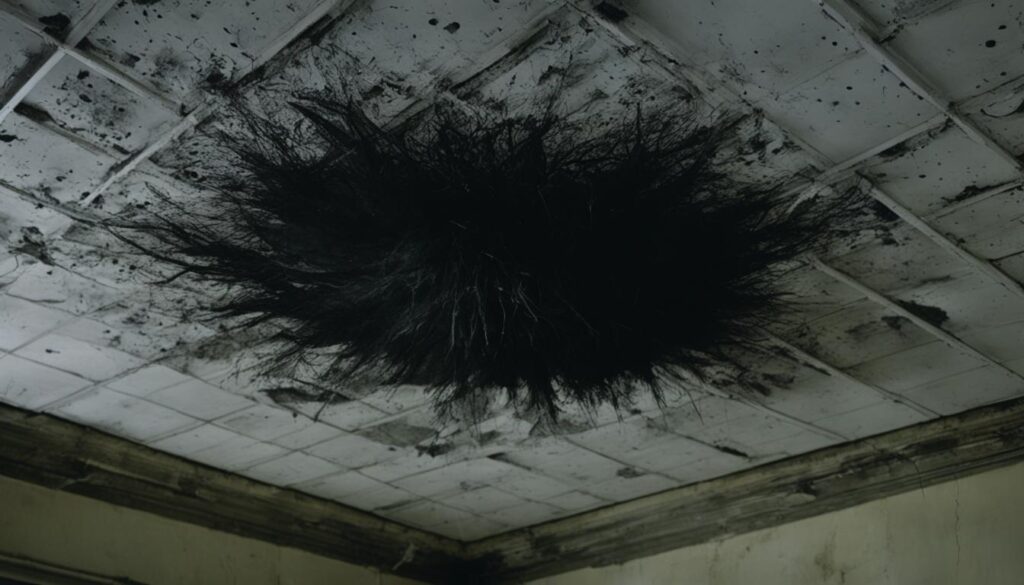
Preventing Black Mold on Ceiling
Preventing black mold on the ceiling is crucial to ensure a healthy indoor environment. Here are some practical tips and strategies you can follow:
Ventilation
Proper ventilation is essential in preventing the growth of black mold on the ceiling. Make sure your indoor spaces have adequate airflow by opening windows, using exhaust fans, and installing a dehumidifier if necessary. Doing so will help control moisture levels and reduce the risk of black mold growth.
Moisture Control
Moisture is the main cause of black mold growth on ceilings. You can prevent moisture buildup by identifying and addressing leaks, fixing plumbing issues, and repairing damaged roof shingles. It’s also essential to keep humidity levels below 60% to avoid creating a suitable environment for mold growth.
Clean Spills Promptly
Any spills or leaks should be cleaned up immediately to prevent the moisture from seeping into the ceiling. Wipe excess water and dry the area with a towel to keep your ceiling dry and prevent mold growth.
Inspect Regularly
Regular inspection of the ceiling and other surfaces will allow you to detect early signs of mold growth and address them promptly. Be sure to check for discoloration, damp spots, and musty odors. If you notice any of these signs, contact a professional for help in cleaning and preventing further mold growth.
Preventing black mold on the ceiling is possible with proper ventilation, moisture control, prompt cleaning of spills, and regular inspections. Taking these preventive measures will help maintain a safe and healthy indoor environment for you and your loved ones.
DIY Removal of Black Mold on Ceiling
Dealing with black mold on the ceiling can be a daunting task, but it is essential to remove it promptly to avoid health hazards and damage to your property. If you prefer the DIY approach, here are some step-by-step instructions to help you carry out DIY black mold removal on the ceiling.
Materials Required
Before starting the cleaning procedure, it is essential to have the following materials:
- Disposable gloves
- Dust mask
- Goggles
- Bleach or Vinegar
- Sponge or rag
- Vacuum cleaner with a HEPA filter
Make sure to wear protective gear throughout the process to avoid exposure to black mold spores.
Steps for Removing Black Mold on Ceiling
Follow these steps to remove black mold on the ceiling:
- Prepare the cleaning solution by mixing one-part bleach with three parts water or use distilled white vinegar as an alternative.
- Don the protective gear to avoid exposure to the black mold spores.
- Turn off the HVAC system to prevent the spread of mold spores to other areas of the house.
- Use the vacuum cleaner with HEPA filters to collect loose mold spores before cleaning the affected area with the cleaning solution.
- Soak the sponge or rag in the cleaning solution and start scrubbing the mold-affected area gently. Do not oversaturate the ceiling as it can damage the drywall.
- Rinse the sponge or rag frequently to avoid spreading the mold spores.
- Once you have removed the mold, dry the affected area with a clean and dry sponge or rag or use fans to speed up the drying process.
- Dispose of the gloves, mask, and rag or sponge in airtight bags to avoid spreading the mold spores.
This method is suitable for small areas with less severe mold infestations. If the mold infestation is extensive or has spread to other areas, it’s best to call the professionals.
In addition to these steps, make sure to identify and fix the source of moisture that led to black mold growth on the ceiling. This will prevent mold from recurring in the future.
DIY black mold removal on the ceiling can be effective, but it’s not always the best solution. Calling mold remediation experts can save you time and guarantee better results.
Professional Mold Inspection and Remediation Services
When dealing with black mold on ceilings, it’s important to rely on the expertise of professionals. Mold Inspection and Assessments can help identify the extent of the mold growth, while offering insight into potential causes or recommendations for Mold Prevention. At Fix Mold Miami, we offer comprehensive Mold Remediation services that aim to fully remove mold from your location to prevent its regrowth.
Our team of experienced technicians is equipped with state-of-the-art equipment and protective gear to safely eliminate mold, adhering to industry-standard safety protocols. We utilize advanced cleaning solutions that ensure effective removal while preserving the integrity of your property. With years of experience in mold remediation, Fix Mold Miami offers reliable, efficient, and affordable services to keep your property safe and free from mold.
“Removing mold from your property requires expertise and specialized equipment. At Fix Mold Miami, we understand the urgency and potential danger of mold growth and offer a range of services to completely remove it from your property.”
Effective Removal Techniques for Black Mold on Ceiling
Removing black mold on the ceiling is critical to maintaining your indoor air quality. While mild cases of mold can easily be removed by following some simple DIY methods, it is often best to leave the job to a qualified professional when dealing with extensive mold infestations. Here are some effective techniques for removing black mold from the ceiling:
1. Use a cleaning solution
There are several cleaning solutions readily available in the market to remove black mold from the ceiling. Ensure that you choose a product specifically designed for the job and follow the instructions carefully. Effective solutions include bleach, hydrogen peroxide, and vinegar.
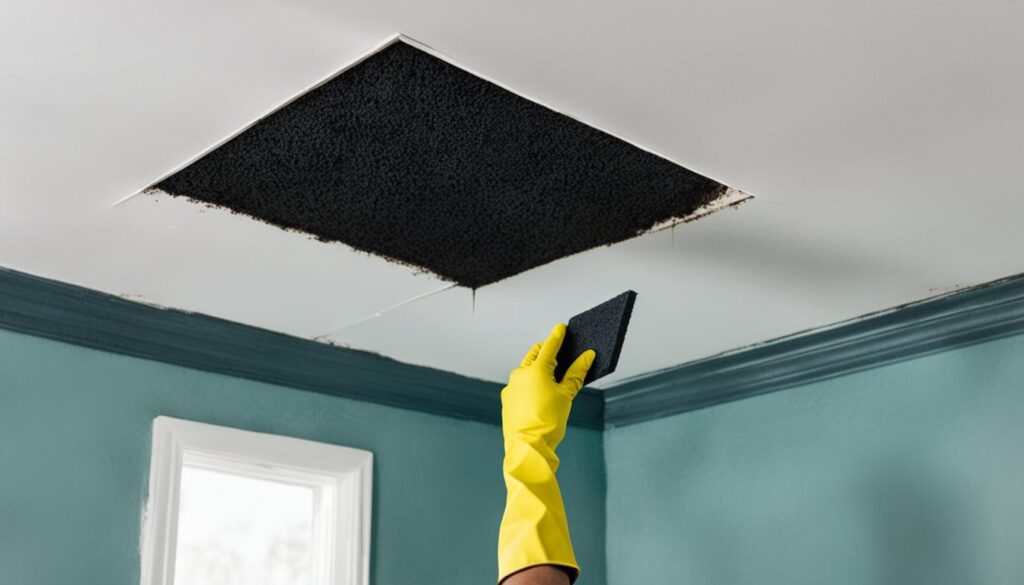
2. Wear protective equipment
It is important to always wear protective gear when dealing with black mold on the ceiling, especially if it is in large quantities. Protective equipment includes gloves, a respirator, and goggles to prevent the inhalation of spores.
3. Consider hiring a professional
If the black mold on your ceiling is extensive and has spread to other areas, it is recommended to hire a professional for safe removal. A qualified and experienced professional can assess the extent of the damage, recommend the best approach, and ensure the job is thoroughly completed.
It is important to note that improper removal of black mold can lead to health problems such as respiratory infections, so it’s best to take the necessary precautions to protect yourself and your loved ones.
Home Remedies for Black Mold on Ceiling
Dealing with black mold on your ceiling can be challenging, but several natural and DIY remedies can help eradicate the problem. These remedies are easy to apply, safe, and cost-effective in comparison to seeking professional help. Below are the top home remedies for black mold on ceiling:
Vinegar Solution
White vinegar is an excellent natural remedy for black mold on ceiling. Mix equal parts of vinegar and water in a spray bottle and apply it directly to the affected area. Allow the solution to sit for an hour or two before scrubbing off the mold with a soft-bristled brush. Rinse the affected area with water and dry it completely. The acetic acid in vinegar is a powerful agent that can kill up to 82% of mold species.
Baking Soda Paste
You can make a paste using baking soda and water to remove black mold from your ceiling. Mix one tablespoon of baking soda with water to make a thick paste. Apply the paste to the affected area with a clean cloth or brush and scrub gently. Rinse the affected area with water and dry it completely. Baking soda is an alkaline compound that can remove black mold naturally and effectively.
Borax Solution
Borax is an excellent natural cleaner that can eliminate black mold on ceiling. Mix one cup of borax with one gallon of water and apply it to the affected area. Allow the solution to sit for 10-15 minutes before scrubbing off the mold. Rinse the affected area with water and dry it completely. Borax is a natural fungicide that can kill black mold and prevent its growth.
Tea Tree Oil Solution
Tea tree oil is a natural fungicide that can help eliminate black mold on ceiling. Mix one teaspoon of tea tree oil with one cup of water in a spray bottle and apply it to the affected area. Allow the solution to sit for a few hours before wiping it off. Rinse the affected area with water and dry it completely. Tea tree oil is safe and can kill up to 99% of mold spores.
Try these home remedies to remove black mold from your ceiling and enjoy a healthy indoor environment. However, if you have a severe infestation, it’s best to seek the help of a professional to avoid further risks.
Conclusion
Black mold on the ceiling is a serious concern that can lead to a range of health problems if left unchecked. Preventing its growth starts with proper ventilation and moisture control. If you do notice signs of black mold on your ceiling, prompt action is necessary to prevent it from spreading. DIY removal methods can be effective, but it’s important to follow safety precautions and use the right cleaning solutions. For more serious cases, professional mold inspection and remediation services such as Fix Mold Miami are available.
Remember that addressing black mold on ceilings is crucial for maintaining a safe and healthy indoor environment. By taking steps to prevent its growth and promptly addressing any issues, you can protect yourself and your loved ones from the potential health risks associated with exposure.
FAQ
What are the signs of black mold on the ceiling?
The signs of black mold on the ceiling may include visible black or dark green patches, a musty odor, water stains, and peeling or bubbling paint.
What are the health risks of black mold on the ceiling?
Exposure to black mold on the ceiling can lead to respiratory issues, allergies, asthma attacks, headaches, skin irritation, and other allergic reactions. It is important to address black mold promptly to prevent these health risks.
How can I prevent black mold from growing on the ceiling?
To prevent black mold on the ceiling, ensure proper ventilation in the room, reduce humidity levels, fix any water leaks or moisture issues, and regularly clean and maintain the area.
Can I remove black mold from the ceiling myself?
Yes, you can remove black mold from the ceiling yourself. However, it is important to take appropriate safety precautions, such as wearing protective clothing and using proper cleaning solutions. Follow step-by-step instructions for effective DIY black mold removal.
Should I consider professional mold inspection and remediation services?
If you have a severe or extensive black mold problem on the ceiling, it is advisable to seek professional mold inspection and remediation services. Professionals have the expertise and tools to properly assess the situation, provide effective treatment, and ensure the mold is fully eradicated.
What are some effective techniques for removing black mold on the ceiling?
Effective techniques for removing black mold on the ceiling include using bleach, vinegar, hydrogen peroxide, or commercial mold removal products. It is important to follow proper safety procedures and thoroughly clean the affected area.
Are there any home remedies for black mold on the ceiling?
Yes, there are some home remedies for black mold on the ceiling. These include using a mixture of baking soda and water, tea tree oil, or grapefruit seed extract. However, it is important to note that home remedies may not be as effective as professional solutions.
What should I do if I spot black mold on the ceiling?
If you spot black mold on the ceiling, it is crucial to take immediate action. Assess the extent of the mold growth, fix any underlying moisture issues, and proceed with the appropriate removal method based on the severity of the problem.

